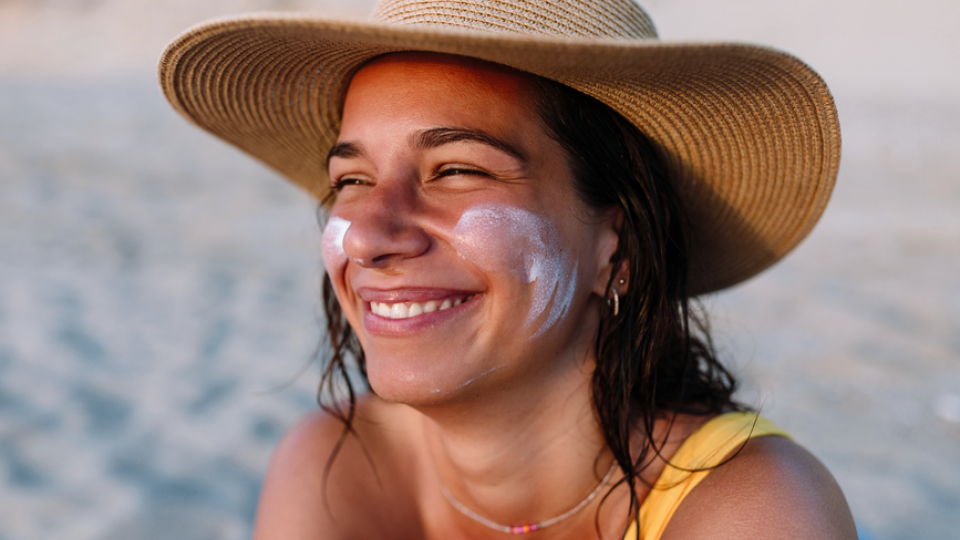
If you’ve seen any of the videos on social media that claim using sunscreen could increase your risk of skin damage or expose you to toxic chemicals, you wouldn’t be alone in having questions, concerns or even doubts about sunscreen safety.
But while online influencers can be, well … influential, you shouldn’t toss your sunscreen before your next beach trip. It's not great for your skin to be exposed to the different types of the sun's ultraviolet (UV) rays: UVA rays play a big part in skin aging, and UVB rays cause those dreaded sunburns (plus UVB exposure is linked to most skin cancers).
Dr. Lindsay Gunnell is a dermatologist at UW Medicine and Fred Hutch Cancer Center who once received treatment for skin cancer herself. She debunks some of the myths flying around about sunscreen and explains why you should keep using it.
Q: Is sunscreen toxic?
Gunnell: There are many misconceptions about sunscreen — some people on social media say it’s unsafe.
However, the Food and Drug Administration (FDA) generally recognizes the two white components of mineral-based sunscreens, titanium dioxide and zinc oxide, as safe for your skin.
Chemical sunscreens are equally effective and have a long track record of safety. These sunscreens can contain ingredients like oxybenzone, avobenzone, octisalate, octocrylene, homosalate and octinoxate. Concerns have recently been raised about the body’s absorption of these ingredients, and the FDA has asked for additional safety data, but we have never seen any associated ill effects from the tiny amounts that are absorbed.
Specifically, there are concerns about endocrine effects or even cancer from social medial influencers, but these concerns are based on tiny studies looking at feeding sunscreen to rats, insects and even fish. This is not at all representative of how sunscreen is used and does not reflect any truth about sunscreen safety that we have already established in human trials.
The single ingredient with more data showing absorption, oxybenzone, has largely been removed from U.S. sunscreen products. I’d recommend a mineral-based sunscreen for toddlers and children.
Q: Does sunscreen block vitamin D from the sun?
Gunnell: It’s a common question: Wait a minute, what about my vitamin D? If I use sunscreen, I’m blocking vitamin D, right?
It’s true — to make vitamin D in your skin, you need UVB rays to do that. That said, no sunscreen is perfect; no sunscreen blocks a hundred percent of rays, and it takes very little UVB to synthesize vitamin D in the skin.
When we look at vitamin D levels in patients who use sunscreen, we see that they generally make plenty of vitamin D. That might not be true for people with deeply pigmented skin or for somebody who completely protects themselves with clothing due to any conditions they might have. So, you might want to check your levels if you have conditions, such as chronic kidney or liver disease, that put you at risk for vitamin D deficiency.
That said, we can also get vitamin D through food. The current stance of the American Academy of Dermatology is that no UV exposure is safe, and we should get our vitamin D through our diet or take a supplement. That’s what I do.
Q: Do you have other tips for protecting skin from the sun?
Gunnell: Don’t put on only one layer of sunscreen and then think that you’ll be protected all day. I recommend applying every hour if you are sweating or swimming and every two hours for non-wet activities. Regarding the best sun protection strategy, I’d suggest sun avoidance or clothing with an ultraviolet protection factor (UPF) of 50+.
If you’re trying to incorporate sunscreen into your skincare routine, you want to go thin to thick. So, the thinnest kinds of products, like serums or thin moisturizers, would go on your skin first. Sunscreen is the last thing you want to put on.
Don’t forget the most commonly missed places in terms of application — your ears, your neck and the backs of your hands — because we see high rates of skin cancers in those areas.
Adapted from content on the UW Medicine Newsroom.

 Healthy ideas for your inbox
Healthy ideas for your inbox





